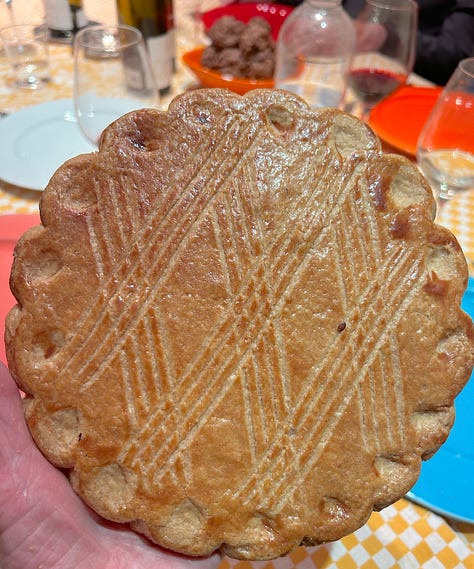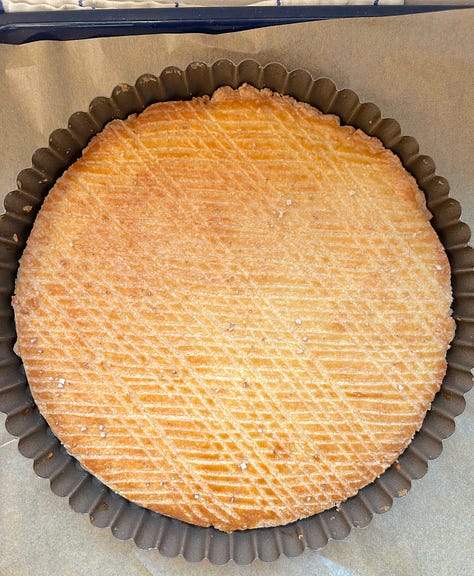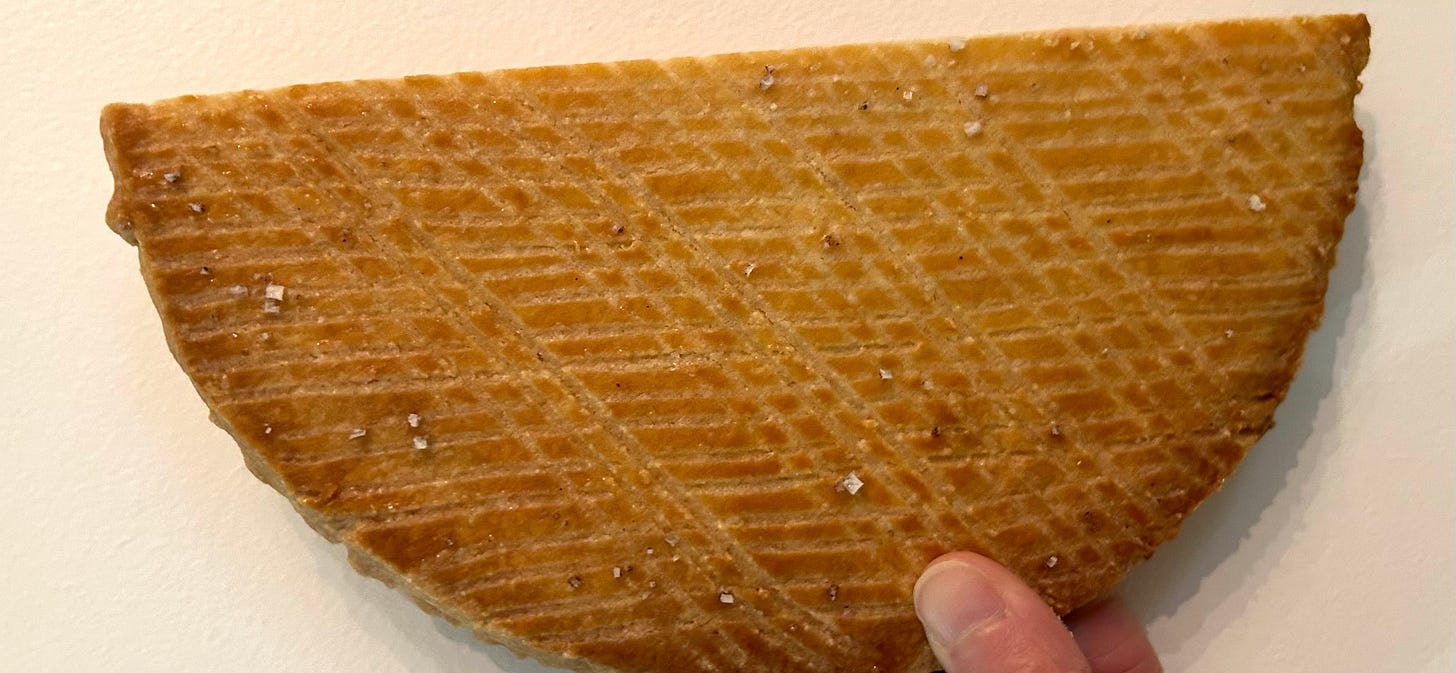Broyé: the cookie-cake you're meant to break
Bake it and break it again and again — and share it with friends.
Hello! Hello!
Well, it’s been a week since I sent you the recipe for scallion pancakes and it’s been a week that I’ve been making them — a lot! I’ve been doubling the recipe and making four rather than two pancakes out of the batch. I did it so that I could feed more friends, but also so that I could use my cast-iron skillet, which is too small for the original 10-inch pancake, and now I do it because it’s fun to have a stack. And, by the way, if you’ve got a choice between a cast-iron skillet or a nonstick pan, pick the cast-iron — you’ll get better color and a crisper crust. I’ve made the pancakes in both pans and we’ve loved all of them, but cast-iron’s my preference.
And now, since I seem to be in make-it-and-make-it-again mode, I’m on to broyé, the giant, buttery shortbreadish cake — maybe a cookie? — famous in the Poitou region of France. Broyé, the name comes from the French verb broyer, to grind, might be the original Friendship Food — it’s one big sturdy cake that’s meant to be messily broken into pieces and generously shared. The top is usually brushed with an egg wash and etched with a crosshatch pattern — so pretty. I was in the habit of making broyé years ago — mostly as thin oversized cookies — but when they popped into my life twice in one week, it seemed like a sign to bake them again.
My broyé moments
The first broyé to turn up came to me directly from its birthplace, Poitou, a part of France famous for its butter. I’d invited friends for dinner in Paris and Nicola arrived after having spent the weekend in the region, where she bought the famous cake at a weekly market. And then, a short time later, when I was at the Salon d’Agriculture in Paris, I was wandering the booths from Charentes and Poitou and, just as I’d hoped, there were the cakes. Inspired by the double sighting, I made my own broyé in my small Paris kitchen and immediately gave it away to my friend, Bernard, who has a special affection for the sweet. (I made that one in a fluted tart pan with a removable bottom — cute, but the process was kind of annoying.) Then, when I got back to Connecticut, I started broyé-ing again. It’s not just that the sweet is delicious, it’s that it’s as much fun to make as it is to bake and share. Also, it’s pretty in a way that I love — it’s exceedingly plain — and tasty beyond expectations.



My old recipe vs. my new
The broyé I started making about 20 years ago was thinner than the regional cakes, and saltier than the cakes I’m making now. In fact, I made the recipe with sel gris, a chunky gray sea salt that keeps its texture when baked. It had the benefit of surprise — you didn’t know when you’d get a salty bite; and the disadvantage of surprise — you didn’t know when you’d hit a hardish nugget of salt. In Paris, I used my standard baking salt — fine sea salt — but I sprinkled the top of the cake with fleur de sel, which was nice in the taste department, but not so nice in the looks department: the salt turned dark in the oven and looked like a mistake rather than an enhancement. So in my latest recipe, I used fine sea salt in the dough and finished the top with sanding sugar — going against tradition, but adding a bit of whimsy and maybe enough charm to make up for my transgression.
Adding an egg was the biggest change that I made. I had been moistening and bringing the dough together with cold water for all these years, somehow oblivious to the fact that the recipe is meant to include an egg. And so, at a time when we’re subtracting rather than adding eggs to our recipes, I dropped one in. A little upside down, I know, but here’s the good news: You can go with the egg or without, it’s a recipe with choices. And while I think the egg-yolk wash on the top is lovely, it could also be water. I’ve put more about tweaks and changes and cookie/cake possibilities in the recipe below.
Breaking with tradition
Since I’d always made the broyé thin, I always brought it to the table and let everyone break off a piece, just as I do with these big cookies. But that’s not the traditional way of sharing this cake — it’s meant to be knuckled in the center. PLEASE DON’T TRY THIS AT HOME! My cake was too thick to knuckle or punch, so I decided to break it with a mallet. My friend Ellen Madere was here, so I gave her the honor of breaking our snack and, as you can see, it didn’t go so well. It wasn’t for lack of will, strength or humor, for sure, the cake was just too thick and too well knit to succumb to her efforts. Oddly enough — and happily — it broke apart easily when lifted and snapped.
Another member of the Friendship Food family
Since this cake almost demands to be shared in the most communal way, I’m tucking it into our collection of Friendship Food recipes. And since whenever I make a friendship food recipe I also make a donation to an organization that helps people in need, this month I’m sending a contribution in honor of you, the wonderful readers who support this newsletter, to World Central Kitchen. I’ve supported WCK on my own for years — still do — and I’ve made several contributions to them from the newsletter. I’ve decided to contribute again this month, when more communities around the world are struggling to feed more people than ever. Thank you, thank you for making this possible.
Bake a cake. Break a cake. It’s a sweet way to share time with friends.
📚 You can find more recipes in my latest book Baking with Dorie, and get ready for Dorie’s Anytime Cakes by pre-ordering at Bookshop.org, Barnes & Noble or Amazon.
ℹ️ Click here for helpful links while using Substack.
👋 Say hello and share what you're making on Facebook and Instagram.











